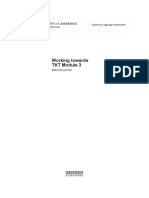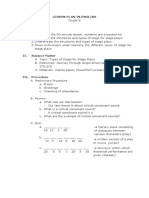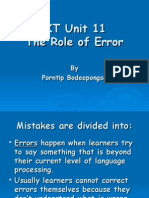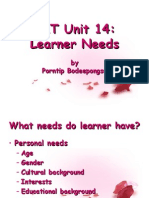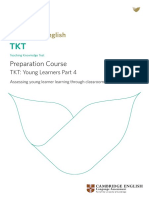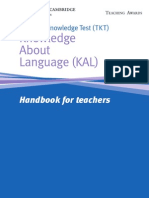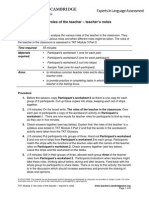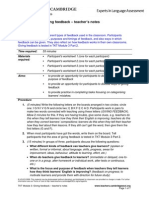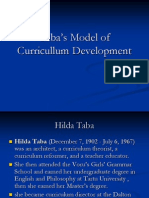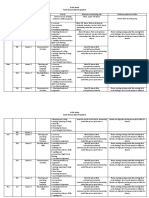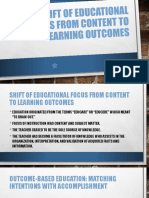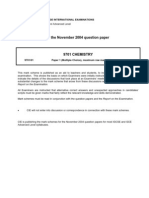TKT Yl Young Learners Part 1 Children As Language Learners and Developing Children S Learning Strategies PDF
TKT Yl Young Learners Part 1 Children As Language Learners and Developing Children S Learning Strategies PDF
Uploaded by
Rachel Maria RibeiroCopyright:
Available Formats
TKT Yl Young Learners Part 1 Children As Language Learners and Developing Children S Learning Strategies PDF
TKT Yl Young Learners Part 1 Children As Language Learners and Developing Children S Learning Strategies PDF
Uploaded by
Rachel Maria RibeiroOriginal Title
Copyright
Available Formats
Share this document
Did you find this document useful?
Is this content inappropriate?
Copyright:
Available Formats
TKT Yl Young Learners Part 1 Children As Language Learners and Developing Children S Learning Strategies PDF
TKT Yl Young Learners Part 1 Children As Language Learners and Developing Children S Learning Strategies PDF
Uploaded by
Rachel Maria RibeiroCopyright:
Available Formats
TKT: YL (Young Learners) Part 1: Children as language learners
and Developing childrens learning strategies Trainers notes
Description
This activity focuses on children as language learners and how they learn language.
Childrens needs and different activities which support them are looked at through a
matching activity. Participants also consider ways of developing childrens learning
strategies. There is also a sample task.
Time required:
Materials
required:
50 minutes
Participants worksheet 1 (one copy for each group of three
participants)
Participants worksheet 2 (one copy for each group of three
participants, cut into strips)
Sample Task (one copy for each participant)
Aims:
to discuss children as language learners and YL classroom activities
to consider ways of developing their learning strategies
to share classroom knowledge and experience
to practise a 1-1 matching task
Procedure
1. Before the session copy Participants worksheets 1 and 2 so there are enough for
each group of three participants. Cut up Participants worksheet 2 into strips. Copy
the Sample task so there is one copy for each participant.
2. Remind or elicit from participants:
TKT: YL focuses on children from 612 years
Part 1 focuses on children as language learners and how language learning can
help young learners to develop learning strategies, cognitive strategies and
communication strategies.
This session focuses on children as language learners and ways of developing
their learning strategies.
3. (5 minutes) In groups of three, participants talk together about the types of classroom
activities that young learners between 6 and 12 years enjoy e.g. songs and chants,
whole class games.
Put the heading Activities in the young learner classroom on the board and
brainstorm ideas from the whole group (see Key below). Point out:
in TKT: YL tasks focus on classroom practice
UCLES 2009. This material may be photocopied (without alteration) and distributed for classroom use provided no charge is made. For further
information see our Terms of Use at http://www.teachers.cambridgeESOL.org/ts/legalinfo
TKT: YL (Young Learners) Part 1: Children as language learners and Developing childrens learning strategies
Trainers notes
www.teachers.cambridgeesol.org
Page 1 of 8
tasks may focus on young children, older children or on a range of
ages between 6 and 12 years
all classroom practice has to consider that young learners are developing
physically, emotionally and cognitively, which makes classes very
different to those of older students
4. (10 minutes) Give out Participants worksheet 1 to groups of three participants.
Working together, participants read some teachers comments about young learner
characteristics and activities. They discuss whether they agree with the comments
and would consider using the activities in class. Feed back with whole group.
5. (10 minutes) Give out Participants worksheet 2, cut into strips, to each group of
three participants. They should match the activities to the comments on
Participants worksheet 1.
6. Feed back with whole group to check answers and share opinions (see Key below).
Point out:
this exercise is similar to the 1:1 matching tasks used in TKT:
YL
they have less than 10 minutes to do similar tasks in the test
7. (10 minutes) Review the session so far, which has discussed children as language
learners and activities that are suitable for them. Explain that you will now move on to
discuss different ways in which children learn English. Write the following ways
children learn on the board:
Memorising Words and Phrases
Reviewing Work
Brainstorm other ideas from participants, writing them on the board (see Key below).
Point out:
TKT: YL Part 1 tests candidates knowledge of ways of developing
childrens language learning strategies through language learning
Test items are objectively tested and put into young learner
classroom contexts. There are examples of this on
Participants worksheet 1 and 2 and also in the Sample task.
8. (10 minutes) Give out Sample Task. Participants work individually to complete the
task. Allow no more than 6 minutes for this (candidates have an average of 1 minute
per question in the TKT: YL exam.) They then compare answers with a partner.
9. Check answers together (see Key below). Point out:
In the test there a total of 80 questions to complete in 1 hour 20 minutes
10. (5 minutes) Round up to review and summarise points covered. Ask participants:
Which part of TKT: YL have they covered? (two areas of knowledge
for Part 1: Childrens characteristics as language learners (theoryfocused) and Developing childrens learning strategies through
language learning)
UCLES 2009. This material may be photocopied (without alteration) and distributed for classroom use provided no charge is made. For further
information see our Terms of Use at http://www.teachers.cambridgeESOL.org/ts/legalinfo
TKT: YL (Young Learners) Part 1: Children as language learners and Developing childrens learning strategies
Trainers notes
www.teachers.cambridgeesol.org
Page 2 of 8
Which task type have they practised? (1-1 matching)
What have they learned about this area of the syllabus and how
confident do they feel about doing test tasks on it?
How can they prepare for this part of TKT: YL? (Participants can:
look at the language demands of their own lessons and decide what type
of support is needed so that learners can understand and produce the
language in spoken and written English.
note any strengths and problems children have in their own classes in
understanding and using key language.)
Additional Information
For information on the other three parts of TKT: YL, see the TKT: YL handbook at
http://www.cambridgeenglish.org/exams-and-qualifications/tkt/how-to-prepare/
Participants can do the Teaching Resources activities for TKT: Task types 1 4,
and TKT: YL Part 1 Developing childrens cognitive and communication strategies
for more information on the test format and content.
https://www.teachers.cambridgeesol.org/ts/teachingresources
UCLES 2009. This material may be photocopied (without alteration) and distributed for classroom use provided no charge is made. For further
information see our Terms of Use at http://www.teachers.cambridgeESOL.org/ts/legalinfo
TKT: YL (Young Learners) Part 1: Children as language learners and Developing childrens learning strategies
Trainers notes
www.teachers.cambridgeesol.org
Page 3 of 8
TKT: YL (Young Learners) Part 1: Children as language learners
and Developing childrens learning strategies answer keys
Key to procedure step 3
Young learner classroom tasks and activities include:
songs and chants
telling stories
whole class games such as I spy
with my little eye
handicrafts e.g. making finger
puppets
making finger puppets
using flashcards
memory games with picture/word
cards
drawing and colouring
picture/word dominoes
stirrers (arousing activities) or settlers
(calming activities)
listen and do e.g. TPR activities
class surveys
mime
circle games
Key to Participants worksheet 2
I always plan whole class activities as an integral part of the lesson as children respond
positively and learn quickly while they are having fun. Playing TPR games
Children learn language in context through their own understanding and experience so I
always try to activate this knowledge when starting new themes. Brainstorming
activities
Children are at different stages of emotional and social development and so I plan
lessons so they feel relaxed and safe as soon as they come into the classroom.
Developing classroom routines
Its interesting how children are able to use whole language chunks such as Have a
good weekend! without knowing any grammar rules. Using classroom language
posters
I always plan further activities to challenge children who finish quickly and may be more
advanced than others in their development. Planning follow-up activities
As each child has their own characteristics such as learning style or previous learning
experience, I always review language in different ways throughout the course to support
these differences. Reviewing language
UCLES 2009. This material may be photocopied (without alteration) and distributed for classroom use provided no charge is made. For further
information see our Terms of Use at http://www.teachers.cambridgeESOL.org/ts/legalinfo
TKT: YL (Young Learners) Part 1: Children as language learners and Developing childrens learning strategies
answer keys
www.teachers.cambridgeesol.org
Page 4 of 8
Key to procedure step 7
self-correcting during speaking activities, pair games or chants
practising English outside the classroom
setting goals
self-assessment tasks e.g. checklists with Can Do statements
organising learning
choosing what to do
using reference resources such as dictionaries and the internet
comparing/contrasting
planning learning
reviewing learning
remembering language or information about language
developing hypothesis about language rules
Key to Sample Task
1. F
2. E
3. D
4. A
5. C
6. G
UCLES 2009. This material may be photocopied (without alteration) and distributed for classroom use provided no charge is made. For further
information see our Terms of Use at http://www.teachers.cambridgeESOL.org/ts/legalinfo
TKT: YL (Young Learners) Part 1: Children as language learners and Developing childrens learning strategies
answer keys
www.teachers.cambridgeesol.org
Page 5 of 8
TKT: YL (Young Learners) Part 1: Children as language learners
and Developing childrens learning strategies Participants
worksheet 1
Childrens characteristics as language learners
Look at these comments by teachers about young learners. Discuss the activities and
characteristics, in particular:
Do you agree with the comments?
Would consider using these activities in your classes?
1. I always plan whole class activities as an integral part of the lesson as children
respond positively and learn quickly while they are having fun.
2. Children learn language in context through their own understanding and experience
so I always try to activate this knowledge when starting new themes.
3. Children are at different stages of emotional and social development and so I plan
lessons so they feel relaxed and safe as soon as they come into the classroom.
4. Its interesting how children are able to use whole language chunks such as Have a
good weekend! without knowing any grammar rules.
5. I always plan further activities to challenge children who finish quickly and may be
more advanced than others in their development.
6. As each child has their own characteristics such as learning style or previous
learning experience, I always review language in different ways throughout the
course to support these differences.
UCLES 2009. This material may be photocopied (without alteration) and distributed for classroom use provided no charge is made. For further
information see our Terms of Use at http://www.teachers.cambridgeESOL.org/ts/legalinfo
TKT: YL (Young Learners) Part 1: Children as language learners and Developing childrens learning strategies
Participants worksheet 1
www.teachers.cambridgeesol.org
Page 6 of 8
TKT: YL (Young Learners) Part 1: Children as language learners
and Developing childrens learning strategies Participants
worksheet 2
Playing TPR games: The class sit on chairs in a circle and the teacher gives commands
such as Change places if you have got a brother/ are wearing a watch etc. One chair is
removed after each change and the child who loses their chair gives the commands.
Brainstorming activities: On introducing the topic Pollution the teacher asks the class for
vocabulary which is linked to it and writes key words/sentences on the board.
Developing classroom routines: The teacher welcomes the class, organizes the room,
and takes the register. Ten minutes before finishing, the children finish their work, put away
materials and the teacher reviews learning.
Using classroom language posters: At the start of term children prepare posters for the
notice boards which review short phrases and sentences used in everyday classroom
language. Children use them throughout the course.
Planning follow-up activities: Children know what to do when they finish a task. This might
include doing a worksheet, playing a memory game to review language or helping a friend to
finish.
Reviewing language: Children can practise language over several weeks through songs,
chants, games and reading stories.
UCLES 2009. This material may be photocopied (without alteration) and distributed for classroom use provided no charge is made. For further
information see our Terms of Use at http://www.teachers.cambridgeESOL.org/ts/legalinfo
TKT: YL (Young Learners) Part 1: Children as language learners and Developing childrens learning strategies
Participants worksheet 2
www.teachers.cambridgeesol.org
Page 7 of 8
TKT: YL (Young Learners) Part 1: Children as language learners
and Developing childrens learning strategies Sample Task
For questions 1 6, match the teachers comments on her approach to learning with the
young learner needs and characteristics listed A G.
Mark the correct letter (A G) on your answer sheet.
There is one extra option which you do not need to use.
Young learner needs and characteristics
Young learners like to have:
A
routines in the classroom
personalised feedback on their language
opportunities to respond to and use language creatively
chance to have fun as a whole class
help with underlying language patterns
physical movement/activity
enough time to complete their work
Teachers comments
1
Theyre often sleepy in the afternoons so we generally do some group project work where
theyre measuring or doing something like a science experiment.
They worry about their spelling so, each week, we choose a vowel sound and brainstorm
all the words we can think of. Then we look at how theyre spelt and categorise them.
One of the things my pupils like most is to learn a chant and then try to say it faster and
faster but still keep in time. That parts really hard!
At the start of the lesson, two pupils give out the books and another writes the date on the
board.
We often do visualisations. They close their eyes and I ask them questions about a story:
Whos in it? Where are they? What happens? Then they draw a picture and write a few
sentences about it.
Ive got a bank of worksheets at the back of the room for fast finishers so that they dont
get bored waiting for everyone else.
UCLES 2009. This material may be photocopied (without alteration) and distributed for classroom use provided no charge is made. For further
information see our Terms of Use at http://www.teachers.cambridgeESOL.org/ts/legalinfo
TKT: YL (Young Learners) Part 1: Children as language learners and Developing childrens learning strategies
Sample Task
www.teachers.cambridgeesol.org
Page 8 of 8
You might also like
- Instructional Design Format From PRCDocument1 pageInstructional Design Format From PRCFitz Jaminit100% (2)
- Gce A Level 2010 CameroonDocument203 pagesGce A Level 2010 Cameroonmunamboa100% (2)
- Unit 27module3Document32 pagesUnit 27module3lilianabor100% (2)
- TKT Unit 16 PracticeDocument8 pagesTKT Unit 16 PracticePorntip Bodeepongse รักในหลวง100% (4)
- TKT Unit 5 - ReadingDocument14 pagesTKT Unit 5 - ReadingPorntip Bodeepongse รักในหลวง100% (2)
- TKT Power Point PresentationDocument26 pagesTKT Power Point PresentationChio Navarro100% (3)
- TKT Kal Part 3 Grammar Other Verb Forms and Patterns PDFDocument9 pagesTKT Kal Part 3 Grammar Other Verb Forms and Patterns PDFRachel Maria Ribeiro100% (1)
- Module 3Document12 pagesModule 3mrahNo ratings yet
- Designing Authenticity into Language Learning MaterialsFrom EverandDesigning Authenticity into Language Learning MaterialsFrieda MishanNo ratings yet
- Types of Stage - LPDocument6 pagesTypes of Stage - LPJulaton Jerico100% (2)
- June 5 June 9 DLLDocument4 pagesJune 5 June 9 DLLAbelSacatani75% (20)
- TKT Yl Young Learners Part 3 Scaffolding Children S Understanding and Use of Language PDFDocument7 pagesTKT Yl Young Learners Part 3 Scaffolding Children S Understanding and Use of Language PDFRachel Maria Ribeiro100% (2)
- TKT Yl Young Learners Part 2 Providing Support and Challenge When Selecting and Using Materials PDFDocument8 pagesTKT Yl Young Learners Part 2 Providing Support and Challenge When Selecting and Using Materials PDFRachel Maria Ribeiro100% (2)
- TKT Yl Young Learners Part 4 Acting On Assessment Evidence PDFDocument8 pagesTKT Yl Young Learners Part 4 Acting On Assessment Evidence PDFRachel Maria Ribeiro100% (2)
- TKT Yl Young Learners Part 2 Using Additional Resources PDFDocument8 pagesTKT Yl Young Learners Part 2 Using Additional Resources PDFRachel Maria Ribeiro100% (3)
- TKT Young Learners Part 1developing - Children's - Cognitive - and - Communication - Strategies PDFDocument8 pagesTKT Young Learners Part 1developing - Children's - Cognitive - and - Communication - Strategies PDFRomina RubioNo ratings yet
- TKT Yl Young Learners Part 2 Lesson Plans PDFDocument12 pagesTKT Yl Young Learners Part 2 Lesson Plans PDFRachel Maria RibeiroNo ratings yet
- TKT Yl Young Learners Part 4 Focuses of Assessing Learning PDFDocument8 pagesTKT Yl Young Learners Part 4 Focuses of Assessing Learning PDFRachel Maria Ribeiro100% (4)
- TKT Yl Young Learners Part 3 Using Practice Activities PDFDocument9 pagesTKT Yl Young Learners Part 3 Using Practice Activities PDFRachel Maria Ribeiro100% (2)
- TKT Yl Part 1 OverviewDocument6 pagesTKT Yl Part 1 OverviewChris Storm100% (1)
- TKT Yl Young Learners Part 4 Purposes of Assessing Learning PDFDocument7 pagesTKT Yl Young Learners Part 4 Purposes of Assessing Learning PDFRachel Maria Ribeiro100% (1)
- TKT Module 2 Identifying and Selecting Lesson Aims PDFDocument7 pagesTKT Module 2 Identifying and Selecting Lesson Aims PDFRachel Maria Ribeiro100% (2)
- TKT YL Trainer NotesDocument120 pagesTKT YL Trainer NotesMohsen50% (2)
- TKT Young Learners SyllabusDocument5 pagesTKT Young Learners SyllabusНиколета Иванова100% (1)
- TKT Module 1: Unit 11 The Role of ErrorDocument29 pagesTKT Module 1: Unit 11 The Role of ErrorBijou LefèvreNo ratings yet
- TKT Yl Sample TestDocument16 pagesTKT Yl Sample TestLiz CGNo ratings yet
- TKT Module 1 GrammarDocument13 pagesTKT Module 1 GrammarSonia Campbell HamiltonNo ratings yet
- TKT Module 2 Using Reference Resources For Lesson Planning PDFDocument6 pagesTKT Module 2 Using Reference Resources For Lesson Planning PDFRachel Maria RibeiroNo ratings yet
- TKT Module 2 - Identifying The Different Components of A Lesson PlanDocument6 pagesTKT Module 2 - Identifying The Different Components of A Lesson PlanDuc NguyenNo ratings yet
- TKT Essentials Online Trainer GuideDocument14 pagesTKT Essentials Online Trainer GuideZardoz501100% (2)
- TKT Unit 11 - ErrorsDocument10 pagesTKT Unit 11 - ErrorsPorntip Bodeepongse รักในหลวง100% (1)
- TKT Module 1 FunctionsDocument9 pagesTKT Module 1 Functionspepeivan2No ratings yet
- TKT Unit 23Document19 pagesTKT Unit 23Porntip Bodeepongse รักในหลวง100% (1)
- TKT Yl Sample Test PDFDocument16 pagesTKT Yl Sample Test PDFJonsen BostonNo ratings yet
- TKT Module 1 Language and Skills DevelopmentDocument9 pagesTKT Module 1 Language and Skills DevelopmentMona Gomez F.No ratings yet
- TKT PreparationDocument2 pagesTKT PreparationOaky TablesNo ratings yet
- TKT Unit 19Document15 pagesTKT Unit 19Porntip Bodeepongse รักในหลวง100% (4)
- TKT Unit 9 MotivationDocument8 pagesTKT Unit 9 Motivationeder zapata100% (1)
- TKT Unit 1Document16 pagesTKT Unit 1Porntip Bodeepongse รักในหลวง100% (11)
- TKT YlDocument12 pagesTKT YlCarolina De Anda MuñozNo ratings yet
- TKT Clil Sample PaperDocument17 pagesTKT Clil Sample PaperKornelia NitaNo ratings yet
- TKT Unit 14Document9 pagesTKT Unit 14Porntip Bodeepongse รักในหลวง100% (3)
- TKT Module 2 Selection and Use of Teaching Aids PDFDocument6 pagesTKT Module 2 Selection and Use of Teaching Aids PDFRachel Maria Ribeiro100% (1)
- TKT Kal Sample PaperDocument16 pagesTKT Kal Sample Papertariq_nuri83% (6)
- TKT Unit 10 - Exposure and Focus On FormDocument10 pagesTKT Unit 10 - Exposure and Focus On FormPorntip Bodeepongse รักในหลวง100% (2)
- TKT - YL - Face - To - Face - Materials - Part 4 PDFDocument20 pagesTKT - YL - Face - To - Face - Materials - Part 4 PDFTJNo ratings yet
- TKT Module 3 Grouping Learners PDFDocument7 pagesTKT Module 3 Grouping Learners PDFRachel Maria RibeiroNo ratings yet
- TKT Unit 7 - ListeningDocument11 pagesTKT Unit 7 - ListeningPorntip Bodeepongse รักในหลวง100% (4)
- TKT Unit 12 - L1 & L2Document7 pagesTKT Unit 12 - L1 & L2Porntip Bodeepongse รักในหลวงNo ratings yet
- TKT Unit 22Document20 pagesTKT Unit 22Porntip Bodeepongse รักในหลวงNo ratings yet
- TKT Test Paper - 2007Document10 pagesTKT Test Paper - 2007Jonsen BostonNo ratings yet
- TKT Module 1 Part 2 TestDocument5 pagesTKT Module 1 Part 2 TestLeo Corona Hernandez100% (2)
- Lesson AimsDocument7 pagesLesson AimsNuria DíazNo ratings yet
- TKT Unit 24Document26 pagesTKT Unit 24Porntip Bodeepongse รักในหลวง100% (2)
- TKT Module 1 Describing Language Phonology PDFDocument9 pagesTKT Module 1 Describing Language Phonology PDFRachel Maria Ribeiro50% (2)
- Unit 21: Planning An Individual Lesson or A Sequence or LessonsDocument12 pagesUnit 21: Planning An Individual Lesson or A Sequence or LessonsNicol VillafuerteNo ratings yet
- Teaching Knowledge Test Knowledge About Language Handbook For TeachersDocument22 pagesTeaching Knowledge Test Knowledge About Language Handbook For Teacherslearn11100% (1)
- TKT Handbook Modules 1 3Document45 pagesTKT Handbook Modules 1 3Laura MorenoNo ratings yet
- TKT Module 2 Choosing Assessment Activities PDFDocument6 pagesTKT Module 2 Choosing Assessment Activities PDFRachel Maria Ribeiro67% (3)
- Teaching Science Through English - A CLIL Approach PDFDocument29 pagesTeaching Science Through English - A CLIL Approach PDFMara Alejandra Franco PradaNo ratings yet
- Young Learners (YL) : Handbook For TeachersDocument27 pagesYoung Learners (YL) : Handbook For TeachersPaula Goulart Scherer100% (1)
- Resources For Teachers TKT ClilDocument4 pagesResources For Teachers TKT ClilRachel Maria RibeiroNo ratings yet
- TKT Yl Young Learners Part 4 Focuses of Assessing Learning PDFDocument8 pagesTKT Yl Young Learners Part 4 Focuses of Assessing Learning PDFRachel Maria Ribeiro100% (4)
- TKT Yl Young Learners Part 2 Lesson Plans PDFDocument12 pagesTKT Yl Young Learners Part 2 Lesson Plans PDFRachel Maria RibeiroNo ratings yet
- Teaching Knowledge Test ClilDocument30 pagesTeaching Knowledge Test ClilLouise Taylor100% (1)
- TKT Yl Young Learners Part 4 Purposes of Assessing Learning PDFDocument7 pagesTKT Yl Young Learners Part 4 Purposes of Assessing Learning PDFRachel Maria Ribeiro100% (1)
- TKT Yl Young Learners Part 3 Using Practice Activities PDFDocument9 pagesTKT Yl Young Learners Part 3 Using Practice Activities PDFRachel Maria Ribeiro100% (2)
- TKT Practical Lesson Planning PDFDocument11 pagesTKT Practical Lesson Planning PDFRachel Maria Ribeiro100% (3)
- TKT Module 3 Teacher Language Appropriacy of Use PDFDocument9 pagesTKT Module 3 Teacher Language Appropriacy of Use PDFRachel Maria RibeiroNo ratings yet
- TKT Module 1 Types of Activities and Tasks For Language and Skills Development PDFDocument9 pagesTKT Module 1 Types of Activities and Tasks For Language and Skills Development PDFRachel Maria Ribeiro100% (2)
- TKT Module 3 Categorising Learners Mistakes PDFDocument6 pagesTKT Module 3 Categorising Learners Mistakes PDFRachel Maria RibeiroNo ratings yet
- TKT Module 2 Using Reference Resources For Lesson Planning PDFDocument6 pagesTKT Module 2 Using Reference Resources For Lesson Planning PDFRachel Maria RibeiroNo ratings yet
- TKT Module 3 Part 1 Functions of Learner LanguageDocument6 pagesTKT Module 3 Part 1 Functions of Learner LanguageGregory RuizNo ratings yet
- TKT Module 3 The Roles of The Teacher PDFDocument8 pagesTKT Module 3 The Roles of The Teacher PDFRachel Maria Ribeiro100% (1)
- TKT Module 3 Grouping Learners PDFDocument7 pagesTKT Module 3 Grouping Learners PDFRachel Maria RibeiroNo ratings yet
- TKT Module 3 Part 1 Functions of Teacher LanguageDocument6 pagesTKT Module 3 Part 1 Functions of Teacher LanguageALFREDO6411No ratings yet
- TKT Module 2 Identifying and Selecting Lesson Aims PDFDocument7 pagesTKT Module 2 Identifying and Selecting Lesson Aims PDFRachel Maria Ribeiro100% (2)
- TKT Module 1 Motivation PDFDocument6 pagesTKT Module 1 Motivation PDFRachel Maria Ribeiro100% (1)
- TKT Module 1 The Role of Error PDFDocument8 pagesTKT Module 1 The Role of Error PDFRachel Maria RibeiroNo ratings yet
- TKT Module 3 Giving Feedback PDFDocument7 pagesTKT Module 3 Giving Feedback PDFRachel Maria RibeiroNo ratings yet
- TKT Module 2 Selection and Use of Teaching Aids PDFDocument6 pagesTKT Module 2 Selection and Use of Teaching Aids PDFRachel Maria Ribeiro100% (1)
- Taba - S Model of Curricllum Development OmarDocument13 pagesTaba - S Model of Curricllum Development OmarYounes LouziNo ratings yet
- Effectiveness of Peer Mentoring in Enhancing The Mathematical Problem Solving Skills of College Students in Bicol UniversityDocument22 pagesEffectiveness of Peer Mentoring in Enhancing The Mathematical Problem Solving Skills of College Students in Bicol UniversityJashell SiloNo ratings yet
- Designing and Conducting Formative EvaluationDocument12 pagesDesigning and Conducting Formative EvaluationHarold JohnNo ratings yet
- The Functional Behavior AssessmentDocument3 pagesThe Functional Behavior AssessmentGrace Panuelos OñateNo ratings yet
- Yearly Lesson Plan Grade 8Document5 pagesYearly Lesson Plan Grade 8Mahdi MirzapourNo ratings yet
- Class 5 EVS-L-15Document2 pagesClass 5 EVS-L-15DHISHNA KHAJURIANo ratings yet
- Chapter 1 - OBE Matching Instruction With AccomplishmentDocument9 pagesChapter 1 - OBE Matching Instruction With AccomplishmentAngel NopuetoNo ratings yet
- Choice-Based Art Education Plan: AtionaleDocument5 pagesChoice-Based Art Education Plan: Ationaleapi-294234192No ratings yet
- An Intervention Study in Grade 3 Based Upon Reciprocal TeachingDocument10 pagesAn Intervention Study in Grade 3 Based Upon Reciprocal TeachingTama PanjaitanNo ratings yet
- The Teaching of LiteratureDocument5 pagesThe Teaching of LiteratureCarmie Lactaotao DasallaNo ratings yet
- Empowering Leaders Professional DevelopmentDocument10 pagesEmpowering Leaders Professional Developmentapi-502786887No ratings yet
- English Week 9 Quarter 3Document4 pagesEnglish Week 9 Quarter 3Jobelle Arenas Buan33% (3)
- Emily Frantz ResumeDocument2 pagesEmily Frantz Resumeapi-314852604No ratings yet
- Assessment Design ChecklistDocument11 pagesAssessment Design Checklistapi-316834958No ratings yet
- 9701 w04 Ms 1Document4 pages9701 w04 Ms 1Hubbak KhanNo ratings yet
- DRRM Accomplishment ReportDocument4 pagesDRRM Accomplishment Reportroger inocencio100% (2)
- Scaffolding RolePlay ConceptDocument3 pagesScaffolding RolePlay ConceptJoseph GalangNo ratings yet
- Assignment OneDocument3 pagesAssignment OneDane SinclairNo ratings yet
- 2ndquarter BusMathDocument3 pages2ndquarter BusMathGinevieve GibertasNo ratings yet
- Exemplar 1-Julie Anne T. PeridoDocument2 pagesExemplar 1-Julie Anne T. PeridoJulie Anne PeridoNo ratings yet
- Jessica Horton - Frit 7235 - Key Assessment 5Document18 pagesJessica Horton - Frit 7235 - Key Assessment 5api-462906372No ratings yet
- Field Study Learning Episode On Teacher's Philosophy of EducationDocument8 pagesField Study Learning Episode On Teacher's Philosophy of EducationFerliza Cudiamat Pacion75% (4)
- ELEMENTARY SCHOOL: K To 12 Learning Action Cell (LAC) PlanDocument2 pagesELEMENTARY SCHOOL: K To 12 Learning Action Cell (LAC) PlanHazel Tulod TapiaNo ratings yet
- 0620 Chemistry: MARK SCHEME For The May/June 2011 Question Paper For The Guidance of TeachersDocument2 pages0620 Chemistry: MARK SCHEME For The May/June 2011 Question Paper For The Guidance of TeachersAYSHAMOHD88No ratings yet
- Full Course Cidb Assessment (Schedule Feb 2022) - Css - Ctmo - FmeDocument4 pagesFull Course Cidb Assessment (Schedule Feb 2022) - Css - Ctmo - FmeNizamuddin AbdullahNo ratings yet
- DLP Science 8 Wk1D3 2nd QTRDocument1 pageDLP Science 8 Wk1D3 2nd QTRLianne Marie CabanginNo ratings yet











